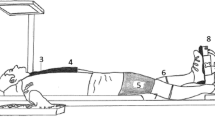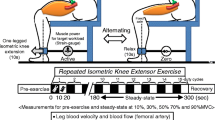Summary
The immediate haemodynamic and metabolic effects of acute dose of diazoxide 300 mg i.v. were studied in six healthy subjects at rest and during dynamic forearm exercise. Control periods of rest, exercise and recovery were compared with corresponding periods after drug administration. Resting forearm blood flow was almost doubled after diazoxide, and during forearm exercise it increased by about 24%. Systolic blood pressure did not change significantly, but diastolic blood pressure was moderately decreased (5–10 mm Hg). The mean heart rate increased from 57 to 92 beats/min immediately after diazoxide administration, and remained about 20% higher throughout the study. There was a sustained increase in arterial blood glucose of almost 1 mmol/l. The arterial concentration of free fatty acids increased transiently just after diazoxide and then returned to the pre-drug level. The arterial concentration of triglycerides after diazoxide was decreased by about 15% throughout the study. Arterial blood lactate remained unchanged. Forearm uptake of oxygen and glucose tended to increase during the exercise and recovery periods, whereas lactate release remained unchanged.
Similar content being viewed by others
References
Graber AL, Porte D, Williams RH (1968) Clinical use of diazoxide and studies of the mechanism of its hyperglycemic effects in man. Ann NY Acad Sci 150: 303–308
Walfish PG, Natale R, Chang C (1970) Beta adrenergic receptor mechanisms in the metabolic effects of diazoxide in fasted rats. Diabetes 19: 228–233
Wahren J (1966) Quantitative aspects of blood flow and oxygen uptake in the human forearm during rhythmic exercise. Acta Physiol Scand Suppl 269: 1–93
Hartling OJ, Svendsen TL, Trap-Jensen J (1980) Haemodynamic and metabolic effects of combined adrenergic α- and β-receptor blockade with labetalol in the exercising human forearm. Eur J Clin Invest 10: 431–435
Hartling OJ, Noer I, Svendsen TL, Clausen JP, Trap-Jensen J (1980) Selective and non-selective β-adrenoreceptor blockade in the human forearm. Clin Sci Mol Med 58: 279–286
Croxton FE (1953) Elementary Statistics with Applications in Medicine and the Biological Sciences, 1st ed. Dover Publications, New York, pp 235–244
Box GEP (1954) Some theorems on quadratic forms applied in the study of analysis of variance problems, II. Effects of inequality of variance and of correlation between errors in the two-way classification. Ann Math Stat 25: 484–498
Bahlmann J, Brod J, Cachovan M (1978) Effect of diazoxide on capitance vessels. Eur J Clin Pharmacol 13: 321–323
Pereda SA, Eckstein JW, Abboud FM (1963) Effect of diazoxide on vascular responses to norepinephrine in the calf of normal subjects. Proc Soc Exp Biol Med 112: 709–712
Powell JW, Green RM, Whiting RB, Sanders CA (1971) Action of diazoxide on skeletal muscle vascular resistance. Circ Res 28: 167–178
Rubin AA, Roth FE, Taylor RM, Rosenkilde H (1962) Pharmacology of diazoxide, an antihypertensive, nondiuretic benzothiadiazine. J Pharmacol Exp Ther 136: 344–352
Wohl AJ, Hausler LM, Roth FE (1968) Mechanism of the antihypertensive effect of diazoxide: in vitro vascular studies in the hypertensive rat. J Pharmacol Exp Ther 162: 109–114
Koch-Weser J (1976) Diazoxide. N Engl J Med 294: 1271–1274
Hinke JAM (1966) Effect of Ca++ upon contractility of small arteries from DCA-hypertensive rats. Circ Res 18–19 (Suppl): 1-23–1-34
Folkow B, Hallbäck M, Jones JV, Sutter M (1977) Dependence on external calcium for the noradrenaline contractility of the resistance vessels in spontaneously hypertensive and renal hypertensive rats, as compared with normotensive controls. Acta Physiol Scand 101: 84–97
Sutter MC, Hallbäck M, Jones JV, Folkow B (1977) Contractile responses to noradrenaline: Varying dependence on external calcium of consecutive vascular segments of perfused rat hindquarters. Acta Physiol Scand 99:166–171
Tobian L, Chesley G (1966) Calcium content of arteriolar walls in normotensive and hypertensive rats. Proc Soc Exp Biol Med 121:340–343
Bhatia SK, Frohlich ED (1973) Hemodynamic comparison of agents useful in hypertensive emergencies. Am Heart J 85:367–373
Wilson WR, Okun R (1963) The acute hemodynamic effects of diazoxide in man. Circulation 28:89–93
Man in 't Veld AJ, Wenting GJ, Verhoeven RP, Schalekamp ADH (1978) Sympathetic and parasympathetic components of reflex cardiostimulation during vasodilator treatment of hypertension. Clin Sci Mol Med 55:329s-332s
Pedersen EB, Kornerup HJ, Geday E, Hansen J (1975) Oral diazoxide treatment of severe arterial hypertension. Dan Med Bull 22:211–214
Blackard WG, Aprill CN (1967) Mechanism of action of diazoxide. J Lab Clin Med 69:960–967
Burr IM, Marliss EB, Stauffacher W, Renold AE (1971) Diazoxide effects on biphasic insulin release: “Adrenergic” suppression and enhancement in the perifused rat pancreas. J Clin Invest 50:1444–1450
Dollery CT, Pentecost BL, Samaan NA (1962) Drug-induced diabetes. Lancet 2:735–737
Fajaans SS, Floyd JC, Knopf RF, Rull J, Guntsche EM, Conn JW (1966) Benzothiadiazine suppression of insulin release from normal and abnormal islet tissue in man. J Clin Invest 45:481–491
Loubatières A, Mariani MM, Alric R (1968) The action of diazoxide on insulin secretion, medullo-adrenal secretion, and the liberation of catecholamines. Ann NY Acad Sci 150:226–241
Senft G (1968) Biochemical aspects of the hyperglycemic action of diazoxide. Ann NY Acad Sci 150:242–255
Tabachnick IIA, Gulbenkian A, Seidman F (1964) The effect of a benzothiadiazine, diazoxide, on carbohydrate metabolism. Diabetes 13:408–418
Sokal JE (1968) Failure of diazoxide to affect carbohydrate metabolism of the isolated liver. Diabetes 17:256–260
Field JB, Mandell S (1964) Effects of thiazides on glucose uptake and oxidation of rat muscle and adipose tissue. Metabolism 13:959–963
Sanbar SS (1967) Metabolism of plasma glucose and lipids following diazoxide administration in dogs. Metabolism 16:259–270
Himms-Hagen J (1967) Sympathetic regulation of metabolism. Pharmacol Rev 19:367–461
Porte D (1968) Inhibition of insulin release by diazoxide and its relation to catecholamine effects in man. Ann NY Acad Sci 150:281–291
Svendsen TL, Hartling O, Trap-Jensen J (1979) Immediate haemodynamic effects of propranolol, practolol, pindolol, atenolol and ICI 89, 406 in healthy volunteers. Eur J Clin Pharmacol 15:223–228
Author information
Authors and Affiliations
Rights and permissions
About this article
Cite this article
Hartling, O.J., Svendsen, T.L. & Trap-Jensen, J. Haemodynamic and metabolic effects of diazoxide during rest and forearm exercise. Eur J Clin Pharmacol 22, 111–116 (1982). https://doi.org/10.1007/BF00542454
Received:
Accepted:
Issue Date:
DOI: https://doi.org/10.1007/BF00542454




